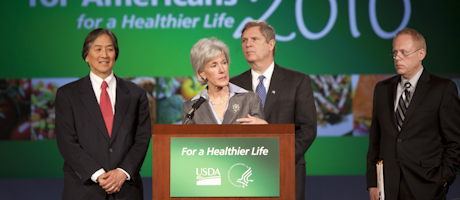A healthier America is a more prosperous America, said Department of Health and Human Services (HHS) Secretary Kathleen Sebelius, who announced the new 2010 Dietary Guidelines for Americans (DGA) alongside Secretary of Agriculture Tom Vilsack at GW Jan. 31.
“We know if we want to become a healthier, stronger, more competitive country, we need to give Americans the tools they need to make healthy choices, so we have a healthier student force and working force,” said Secretary Sebelius, speaking in the Jack Morton Auditorium.
Reviewed and updated every five years, the DGA is the federal government’s evidence-based nutritional guidance to promote health, reduce the risk of chronic diseases, and reduce prevalence of obesity through improved nutrition and physical activity.
Secretaries Sebelius and Vilsack discussed a few of the DGA’s revised recommendations, which include an increase in amounts of lean proteins such as fish and seafood, vegetables and fruits, low-fat dairy and whole grains; a reduction in consumption of sugar, sodium and saturated fat; and increased exercise.
The DGA also places additional emphasis on food safety, said Secretary Vilsack, noting the importance of properly cleaning, separating, cooking and chilling food.
“Whether it’s instructions in terms of how you can lose weight with ‘calories in or calories out,’ a focus on nutritionally dense calories as opposed to empty calories, or the notion of physical activity and food safety, this [document] is a comprehensive science-based effort,” he said.
In her remarks, Secretary Sebelius said the nation’s increased obesity rates are elevating people’s risk of chronic diseases such as heart disease, stroke and certain cancers—and all at a “tremendous cost on our nation’s prosperity.”
“One of the most important things we can do is get people information based on the latest science and research, so they can make the best choices for themselves and their families,” said Secretary Sebelius. “That’s really what the latest additions of the dietary guidelines are all about: concrete steps that every family can take to incorporate into their everyday lives and improve the lives of themselves and their children.”
Noting the challenges that many families face in leading healthier lives, including financial restrictions, Secretary Sebelius said the revised DGA will equip Americans with the best tools to invest in their health.
“With this new addition of dietary guidelines, we’re putting some of the best information into people’s hands and that’s a real step forward,” she said. “It’s going to help us become a healthier country, a more productive country, and a more competitive country.”
The U.S. Department of Agriculture and HHS will release supplementary consumer-friendly advice and tools, including a “next generation food pyramid,” in the coming months. Following their remarks, Secretary Vilsack, Assistant Secretary for Health Howard Koh, and Robert C. Post, deputy director for the Center for Nutrition Policy and Promotion, took questions from the audience.
Secretary Sebelius also thanked Lynn Goldman, dean of GW’s School of Public Health and Health Services, and GW President Steven Knapp for the university’s continued support of HHS initiatives, noting that GW also hosted the unveiling of HHS’ tobacco control strategy in November.
“I think it’s appropriate to be here at GW, which has had such a leadership role in the health of all Americans,” she said.


